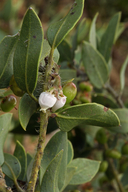Taxon Report
Arctostaphylos pilosula Jeps. & Wies.Santa Margarita manzanita |
 © 2006 Steve Matson |
Taxon Summary
Arctostaphylos pilosula, commonly known as Santa Margarita manzanita, is a perennial evergreen shrub in the Ericaceae that is found only in California. It occurs within Broadleafed upland forest, Chaparral, Cismontane woodland, and Closed-cone coniferous forest, growing at elevations from 75 to 1100 meters. Arctostaphylos pilosula is ranked 1B.2, Plants Rare, Threatened or Endangered in California and Elsewhere; Moderately threatened in California.Classification
|
Scientific Name: |
Arctostaphylos pilosula Jeps. & Wies. |
|
Common Name: |
Santa Margarita manzanita |
| Family: | Ericaceae |
| Element Code: | PDERI042Z0 |
| USDA Plants Symbol: | ARPI |
|
Synonyms/Other Names: |
|
Ecology and Life History
| Lifeform: | perennial evergreen shrub |
| Blooming Period: Dec-May | Dec-May |
| Elevation: | 75-1100 (245-3610) |
| General Habitats: | Broadleafed upland forest, Chaparral, Cismontane woodland, Closed-cone coniferous forest |
| Microhabitat: | Sandstone (sometimes) |
| Microhabitat Details: |
Conservation Status
| CA Rare Plant Rank: | 1B.2 |
| Global Rank: | G2? |
|
State Rank: |
S2? |
| State List: | None |
| Fed List: | None |
| Other Status: | BLM_S; SB_SBBG; USFS_S |
|
CRPR Changes: |
|
Occurrence Data from the CNDDB
| Total Occurrences: | 58 |
| Element Occurrence Ranks: | |
| Excellent (A) | 5 |
| Good (B) | 5 |
| Fair (C) | 4 |
| Poor (D) | 6 |
| None (X) | 0 |
| Unknown (U) | 38 |
| California Endemic: True | |
| California Counties and Islands: Name (Code) | |
| San Luis Obispo (SLO) | |
| Quads: Name (Quad Code) | |
| Arroyo Grande NE (3512025), Atascadero (3512046), Caldwell Mesa (3512023), Huasna Peak (3512013), La Panza (3512032), Lopez Mtn. (3512035), Morro Bay South (3512037), Nipomo (3512014), Oceano (3512015), Pismo Beach (3512026), Port San Luis (3512027), Pozo Summit (3512033), San Luis Obispo (3512036), Santa Margarita Lake (3512034), Tar Spring Ridge (3512024) | |
Threat List Data from the CNDDB
| Threat List Total: | 13 | |
| EOs with Threat Listed: | Total EOs | % of EOs |
| 24 | 41 % | |
| Development | 14 | 24% |
| Road/trail construction/maint. | 7 | 12% |
| ORV activity | 5 | 8% |
| Wood cutting or brush clearing | 4 | 6% |
| Grazing | 3 | 5% |
| Mining | 3 | 5% |
| Non-native plant impacts | 2 | 3% |
| Erosion/runoff | 2 | 3% |
| Other | 2 | 3% |
| Improper burning regime | 2 | 3% |
| Agriculture | 1 | 1% |
| Dam/Inundation | 1 | 1% |
| Hybridization | 1 | 1% |
Selected References
| Erythea 8(13): 101. (1938) |
Citation
California Native Plant Society, Rare Plant Program. 2025. Rare Plant Inventory (online edition, v9.5.1). Website https://www.rareplants.cnps.org [accessed 27 December 2025].